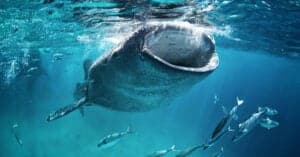Many people hesitate to set up a saltwater tank because it can be expensive. If you know which fish to look for, it doesn’t have to cost an arm and a leg to put together a beautiful saltwater tank. There are many wonderful cheap saltwater aquarium fish to choose from!
Spend most of your aquarium budget on good-quality equipment. These items are essential to keep the fish happy and healthy.
Then, get some cheaper saltwater fish to spruce up your new tank. There are a surprising number of beautiful saltwater fish that you can buy for between $10-60.
Below, I’ve covered some of the most popular and cheapest saltwater fish available.
1. Ocellaris Clownfish
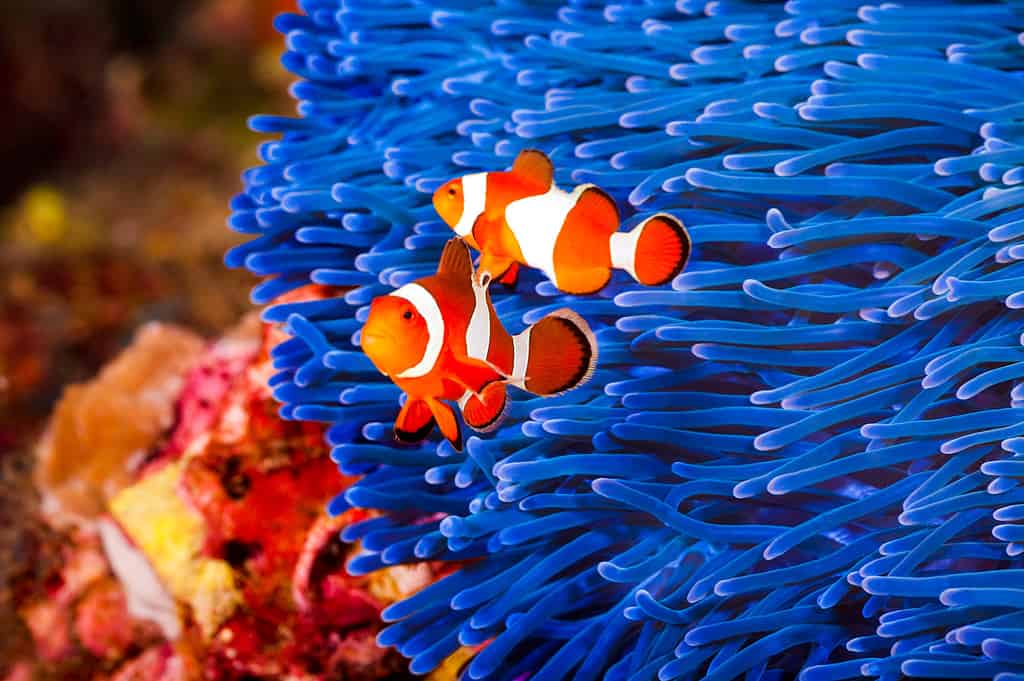
Clownfish
make their homes inside the tentacles of anemones.
©iStock.com/Aneese
Clownfish get their names from their erratic swimming behaviors and goofy personalities.
These fish became popular with the release of the movie Finding Nemo in 2003. They have beautiful, varying colors and are fascinating to watch swimming around.
There are many kinds of clownfish. Ocellaris clownfish are the cheapest, most common, and easiest to care for.
Ocellaris clownfish (Amphiprion ocellaris) are orange and white-striped fish. They are the ones that people usually associate with clownfish.
These clownfish are also known as common clownfish or false percula clownfish.
Clownfish form symbiotic relationships with anemones, animals that have stinging tentacles.
The fish use the anemones for protection. They are immune to their sting, while other animals are not. So, clownfish live inside of anemones and lay their eggs there.
The clownfish are helpful to anemones because they eat harmful parasites. They also provide anemones with food.
2. Royal Gramma
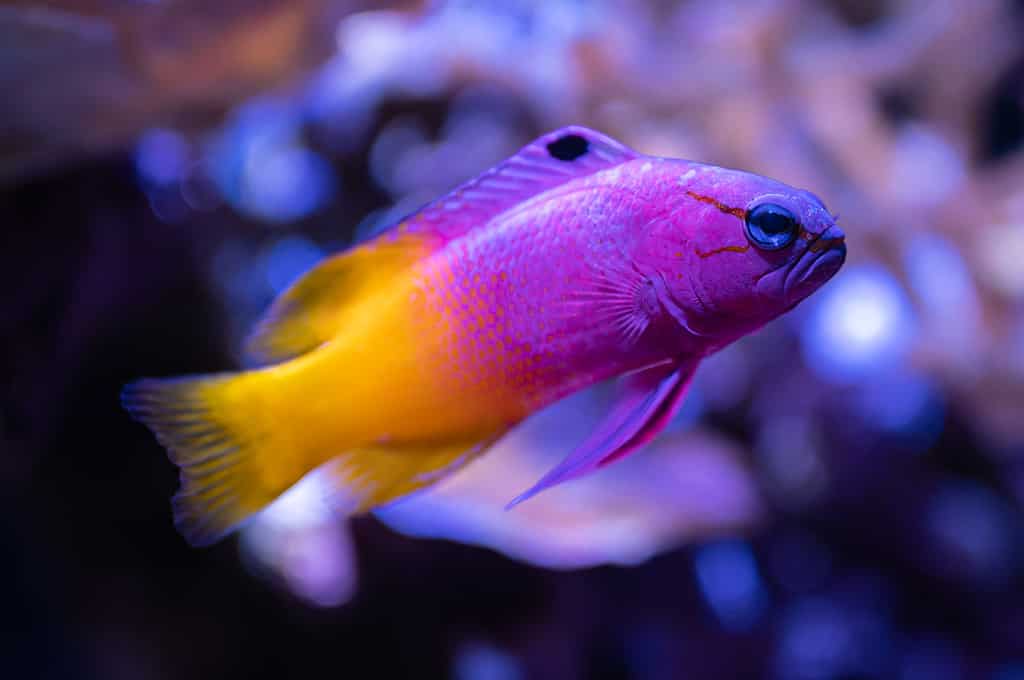
Royal Grammas have bold colors and are very popular for aquariums.
©sebartz/Shutterstock.com
These colorful but small fish only grow to about 3 inches long. They are perfect for smaller tanks of about 30-40 gallons.
Royal Gramma basslets are highly popular for their colors. They have vibrant, almost neon, purple, and yellow coloration.
In the wild, royal Grammas find homes in caves and clustered rockwork. The light is low in these areas, and they feel safe. Royal Grammas live off of the Caribbean in deep-water reefs.
3. Banggai Cardinalfish
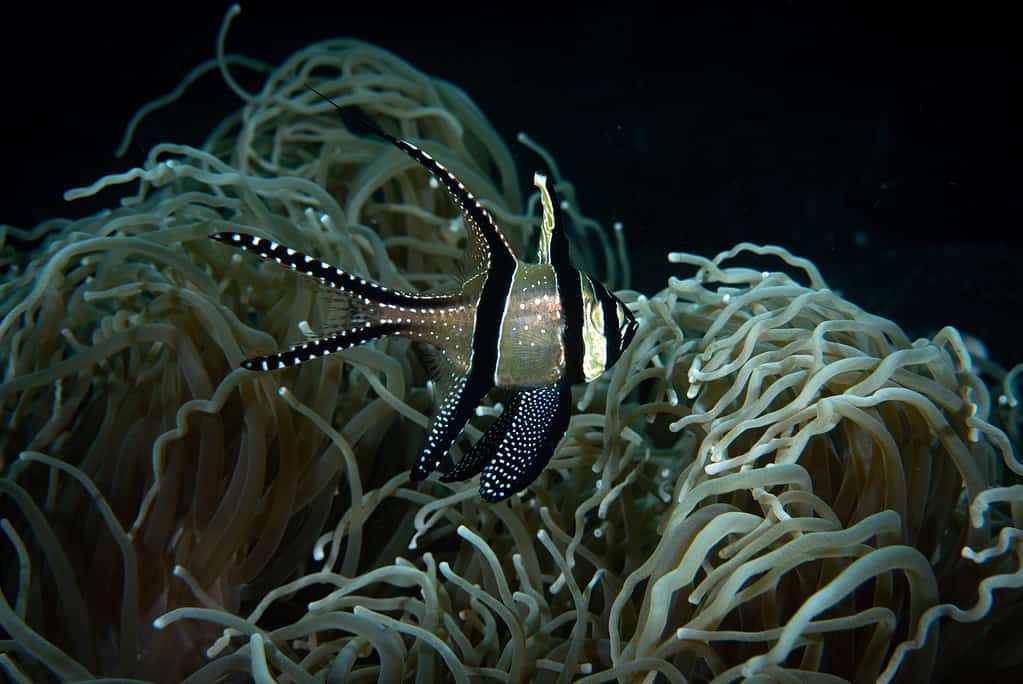
The Banggai Cardinalfish has bold, contrasting colors and long fins.
©iStock.com/Francesco Ricciardi
These fish are some of the most striking little critters. They have long, slender fins that poke from their bodies like spikes.
Banggai cardinal fish aren’t as colorful as clownfish or royal Grammas. Instead, they have alternating black and white stripes and some white spotting. Still, their peculiar shape makes up for the lack of color.
Banggai cardinalfish (Pterapogon kauderni) get their name from where they live. They are native to the Banggai Archipelago in Indonesia.
These cardinalfish are hardy animals that are good for beginners. They are also safe for living inside reef tanks.
Banggai cardinalfish are peaceful and safe to keep with other community species. They tend to be territorial toward members of their species. It’s best to keep them singly or in a mated pair.
4. Pajama Cardinalfish
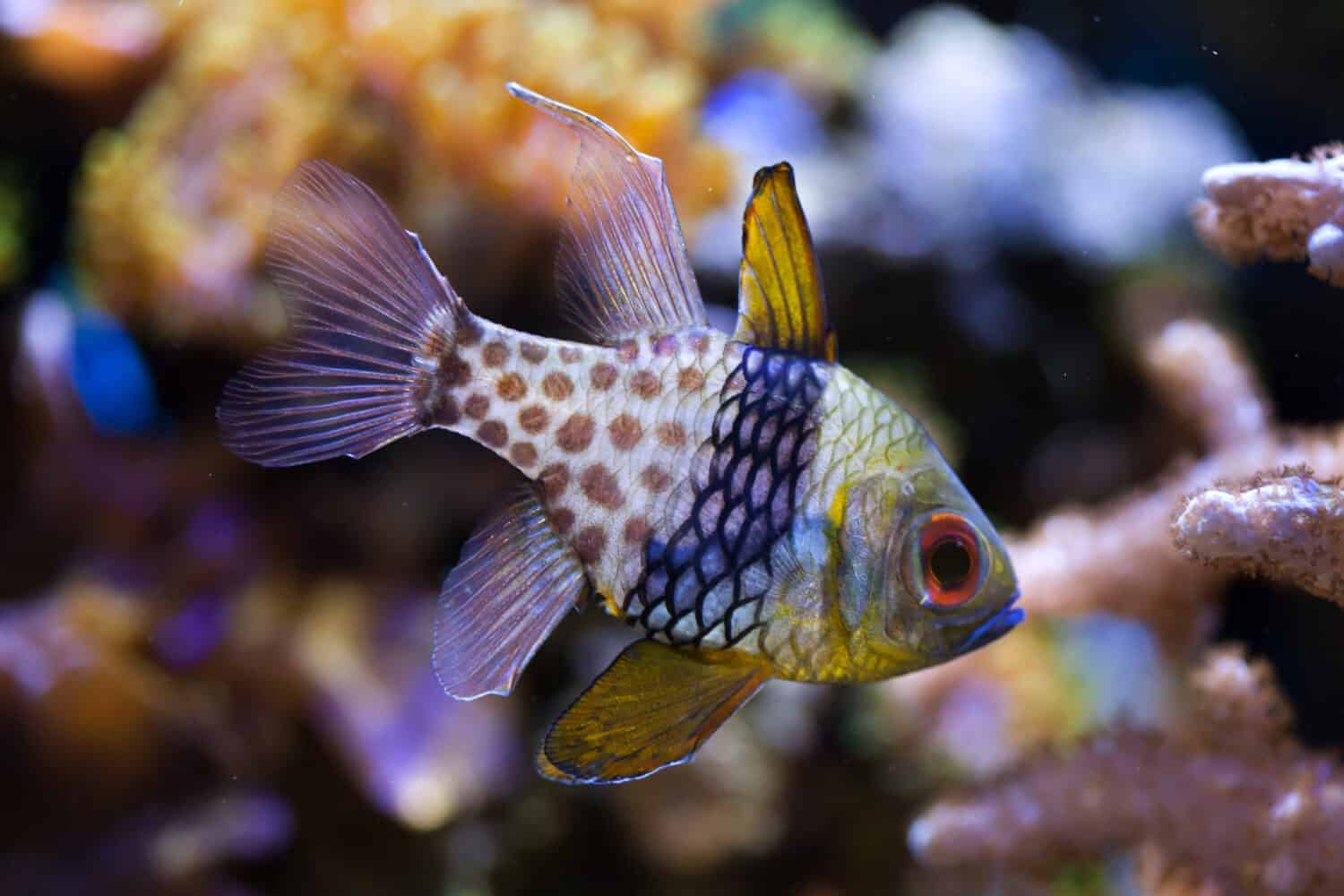
Pajama cardinalfish have colorful patterns of crisscrossed lines and spots.
©Vladimir Wrangel/Shutterstock.com
These cardinalfish have fins that are shorter and broader than the Banngai cardinalfish.
Instead, they are more colorful with their yellow faces. A large black stripe runs down their bellies, with purple spots on their white backsides. Their bright red eyes also stand out in stark contrast to their yellow faces.
Interestingly, pajama cardinalfish are mouthbrooders. The males carry their fertilized eggs in their mouths until they are ready to hatch. Keeping the eggs in their mouths keeps them safe from predators.
Pajama cardinalfish (Sphaeramia nematoptera) are less territorial than their Banggai relatives. They are more social and live in groups amongst the corals in their habitats.
5. Green Chromis
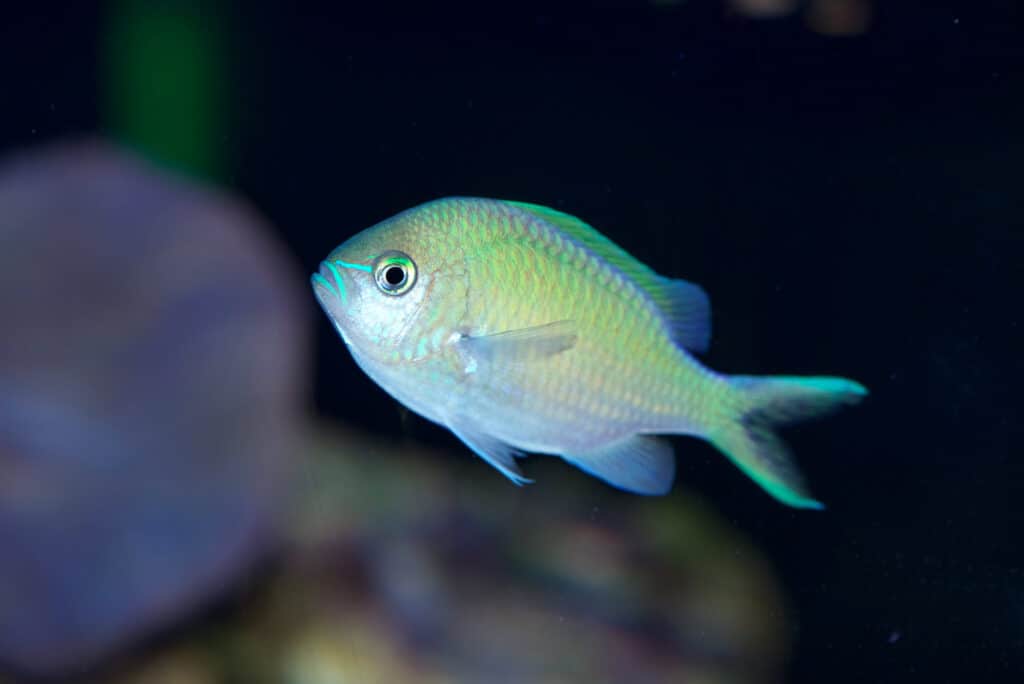
Blue Green Chromis,
Chromis viridis, is a popular and peaceful aquarium fish from the Indo-Pacific Oceans.
©PAUL ATKINSON/Shutterstock.com
This small fish is a type of damselfish, though they are very peaceful. Other damselfish are notorious for their feisty personalities.
Green Chromis (Chromis viridis) like to live in small schools of three to five individuals. Because of the shimmering effect, their blue-green iridescent bodies confuse predators.
These small fish are hardy, cheap, and safe to keep with most other saltwater community fish. They are also reef-safe — they won’t bother invertebrates or corals.
Green Chromis are among the most popular saltwater aquarium fish. Hobbyists love them because of their active and curious personalities.
6. Mandarin Dragonet
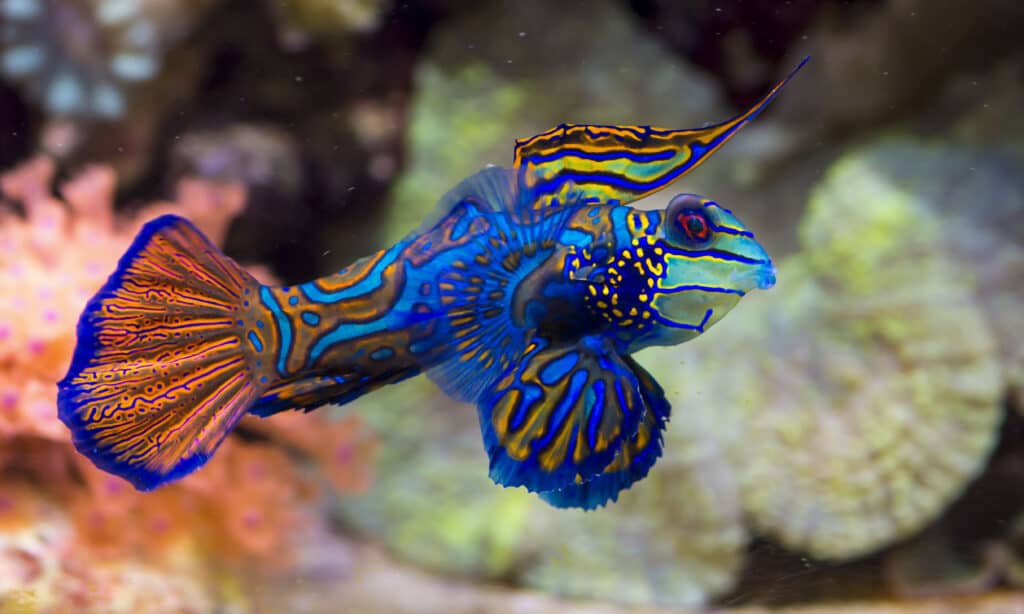
The Mandarin dragonet has some of the most vibrant colors of any saltwater fish.
©Dobermaraner/Shutterstock.com
There are 139 species of dragonets. The Mandarin dragonet (Synchiropus splendidus) is one of the most popular. The Mandarin dragonet has a swirling, vibrant pattern. Their colors comprise electric blues, greens, and oranges.
These bottom-dwelling fish are peaceful and suitable for most community saltwater tanks. They add a colorful layer to the bottom of any tank.
Mandarin dragonets even have curious personalities. They are known for digging themselves into the sand so only their eyes poke out. They are shy fish but often perch on rocks within their habitat.
Mandarin dragonets have stout bodies and large heads. Despite their body shapes, their fins allow them to swim quickly.
7. Lawnmower Blenny
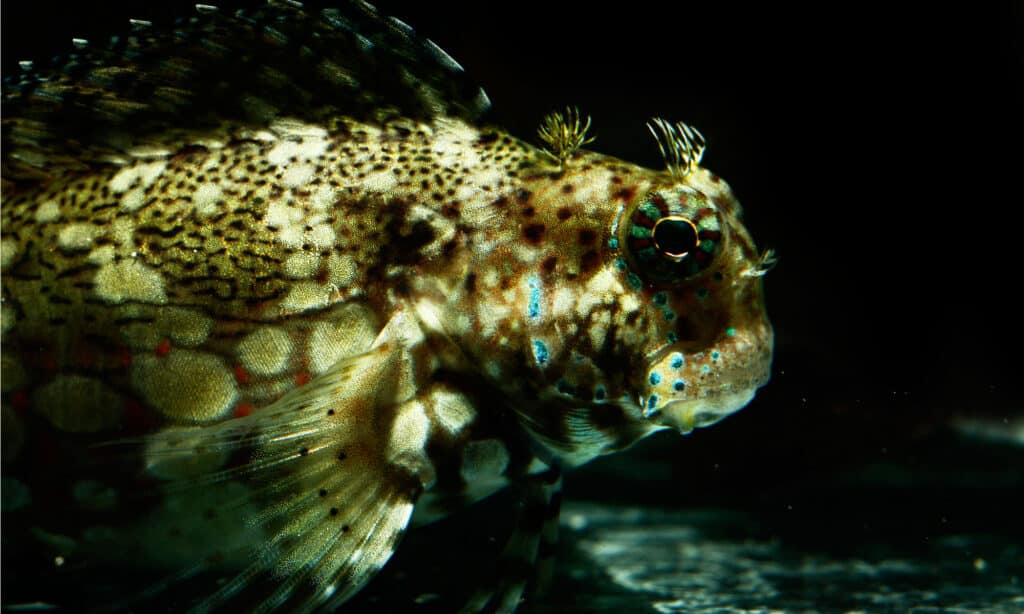
Lawnmower blennies (
Salarias fasciatus) are the perfect algae eaters.
©Pavaphon Supanantananont/Shutterstock.com
These blennies are not the most colorful fish. They have light, sandy bodies that help them blend in with their habitat.
Still, they change colors depending on their environment to blend in. They also change color depending on their mood.
Additionally, lawnmower blennies have some striping and spotting on their bodies.
Lawnmower blennies (Salarias fasciatus) make up for their dull colors by being useful. They are one of the best algae eaters available, which is where they get their name.
These fish are jeweled rockskippers, banded blennies, and algae blennies.
8. Longnose Hawkfish
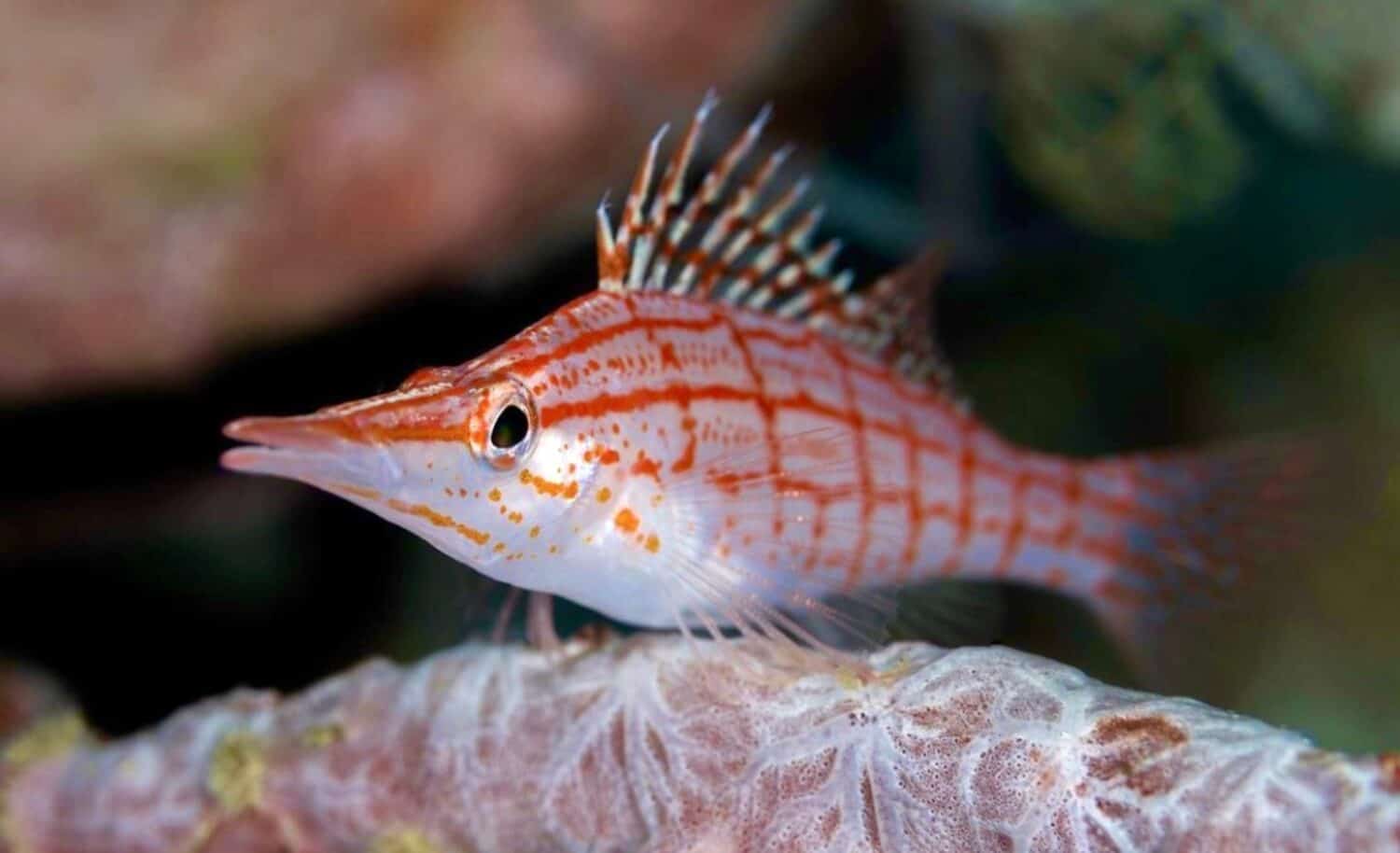
The longnose hawkfish loves to perch on rocks and watch what’s happening around them.
©everything is calm/Shutterstock.com
These hawkfish get their name because of their long, pointed snouts. Their noses help them pluck up their food easily.
Longnose hawkfish have colorful whitish-pink bodies with bright orangish-red stripes and spots. Their transparent fins are adorned with orangish-red stripes. The dorsal fin ends in sharp rays.
Longnose hawkfish (Oxycirrhites typus) are hardy and easy to care for. They need a tight-fitting lid so they don’t jump out of the aquarium.
They are semi-aggressive and eat smaller fish and shrimp in the tank. These fish are only about 5 inches long and can’t stand up against larger, more aggressive species.
Longnose hawkfishes like to perch on rocks. They sit and watch what’s happening around them, like dragonets.
9. Yellow Watchman Goby

The bright yellow watchman goby has small, light blue spots covering its yellow body.
©Kurit afshen/Shutterstock.com
These gobies are one of the most striking bottom-dwelling fish you can own. Their vibrant, sunshine-yellow bodies have specks of tiny, light bluish-green spots.
Yellow watchman gobies (Cryptocentrus cinctus) are hardy fish. They are mostly peaceful and easy to keep for beginners. They do well with other peaceful species but are territorial around other gobies.
Yellow watchman gobies form symbiotic relationships with pistol shrimp. The shrimp have poor eyesight, so the gobies watch out for predators and warn the shrimp. In exchange, the shrimp allow the yellow watchman gobies to live in their holes for shelter.
Like Mandarin dragonets, these gobies enjoy burrowing under the sand and rockwork.
10. Firefish Goby

The firefish goby’s body has a gradient of color that ranges from white to deep red.
©bluehand/Shutterstock.com
These gobies have long, slender, and light-colored bodies. Their bodies are whitish toward their heads. They become gradually darker toward their tails.
Firefish gobies (Nemateleotris magnifica) get their name from their thin, vibrant red fins. Their heads are round and blunt, with large eyes. One of their most popular features is the long, slender, pointed dorsal fin. It juts from the fish’s heads like spikes.
These gobies are peaceful and friendly toward other fish. They are not territorial or aggressive. They are speedy swimmers, so they rarely worry about hostility from other fish. Timid fish usually hide from other fish when they feel threatened.
Firefish gobies are excellent jumpers, so a tightly fitted lid is necessary to keep them safe.
11. Coral Beauty Angelfish
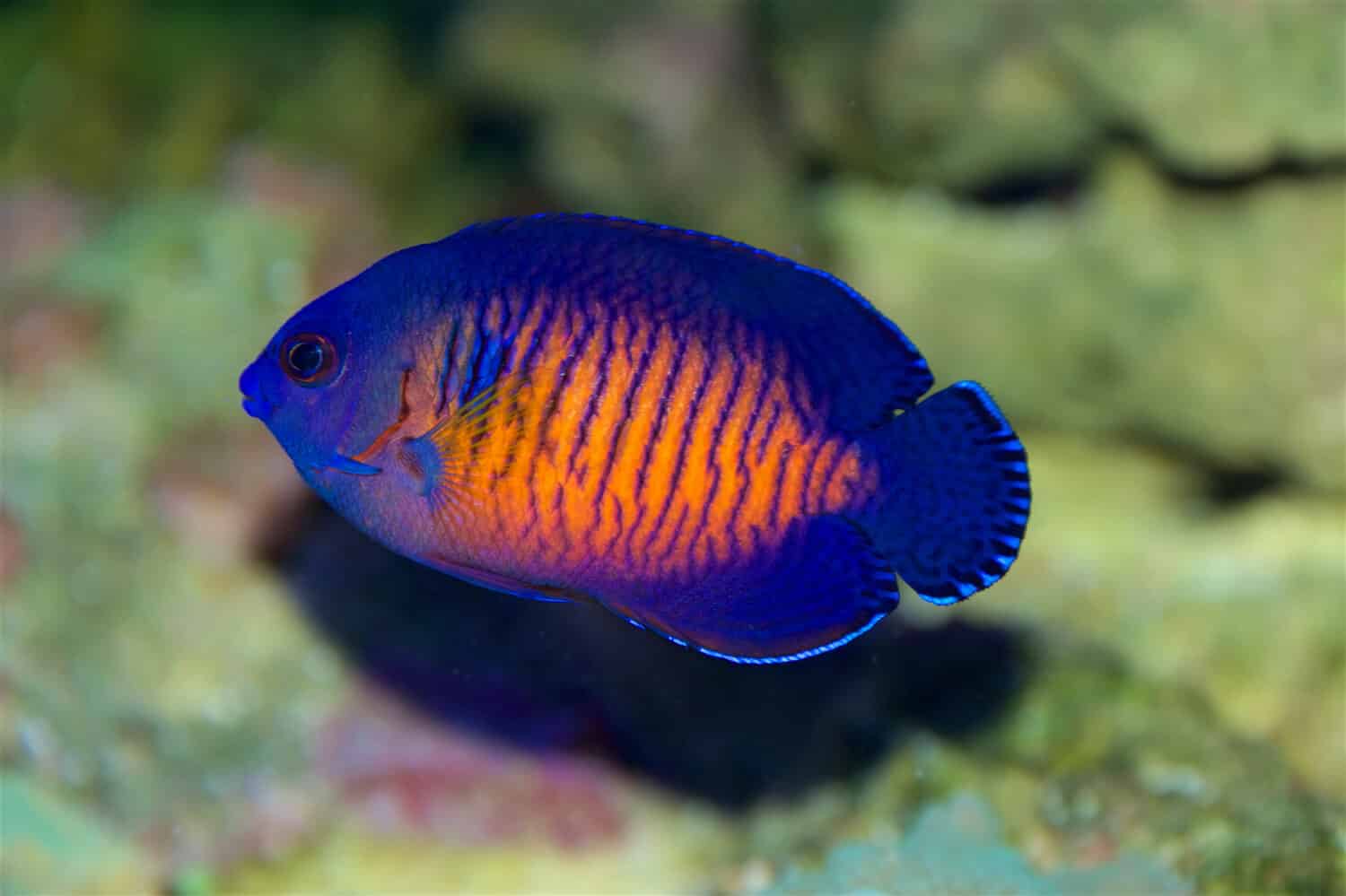
The small coral beauty
angelfish
has some of the most vivid colors in the oceans.
©PAUL ATKINSON/Shutterstock.com
Coral Beauties are dwarf angelfish. Their smaller size is one reason they are so much cheaper than other angelfish.
These dwarf angels only get up to about 4 inches long. They have brilliant bodies of deep blues, bright oranges, and yellows.
Coral beauty angelfish (Centropyge bispinosa) are easy to care for.
These angels are semi-aggressive and won’t tolerate another angelfish in their space. They are also unsuitable for reef tanks since they will pick at soft and stony corals.
Summary Of The 11 Cheapest Saltwater Aquarium Fish To Buy On A Budget
| Scientific Name | Average Cost | |
|---|---|---|
| Ocellaris Clownfish | Amphiprion ocellaris | $15-20 |
| Royal Gramma | Gramma loreto | $20-35 |
| Banggai Cardinalfish | Pterapogon kauderni | $25-40 |
| Pajama Cardinalfish | Sphaeramia nematoptera | $15-35 |
| Green Chromis | Chromis viridis | $6-15 |
| Mandarin Dragonet | Synchiropus splendidus | $30-60 |
| Lawnmower Blenny | Salarias fasciatus | $15-50 |
| Longnose Hawkfish | Oxycirrhites typus | $55-90 |
| Yellow Watchman Goby | Cryptocentrus cinctus | $20-40 |
| Firefish Goby | Nemateleotris magnifica | $20-40 |
| Coral Beauty Angelfish | Centropyge bispinosa | $40-130 |
FAQs
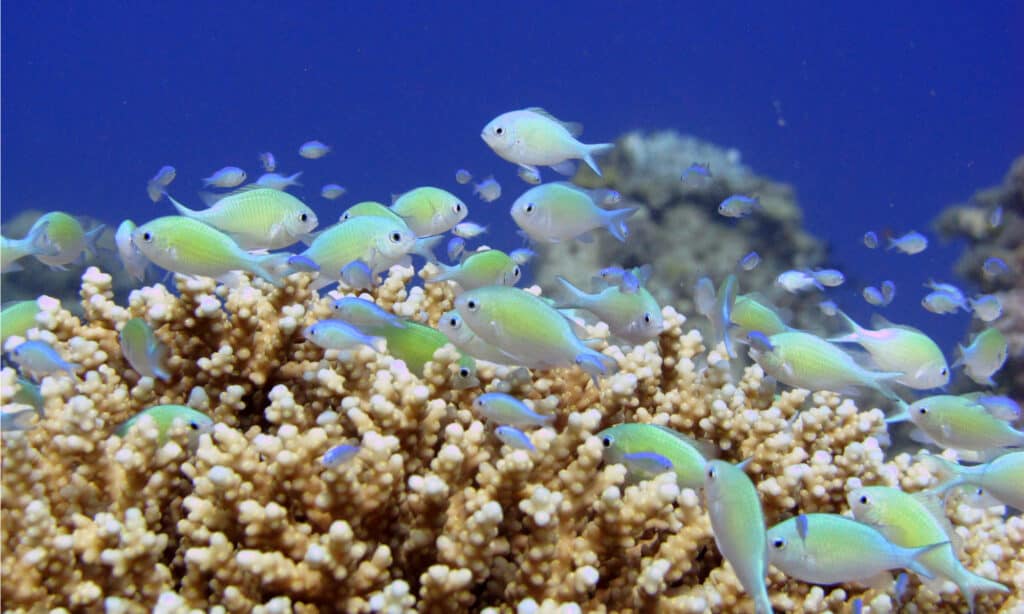
A school of the green Chromis (
Chromis viridis) swimming amongst the coral.
©Kristina Vackova/Shutterstock.com
What saltwater fish can go in a 55-gallon tank?
Some saltwater species that can live in a 55-gallon tank include the following:
- Blue Chromis
- Pink skunk clownfish
- Royal Gramma
- Mandarin dragonet
- Ruby red dragonet
- Flame hawkfish
You’ll need to stick to smaller fish, typically under 5 inches long, if you want to keep a 55-gallon tank.
You will also want to stick with a few fish that you love rather than trying to stuff the aquarium full of fish. An overcrowded tank can cause the water to become dirty and unsafe for fish.
How many saltwater fish can I keep in a 30-gallon tank?
The number of saltwater fish you can keep in a 30-gallon tank depends on the type and size of the fish. There aren’t many saltwater fish that are small enough to live in a 30-gallon tank.
A general rule of thumb is only to keep 1 inch of full-grown fish per gallon of water. So, if the fish you want is 3 inches fully grown, you shouldn’t keep more than ten fish in the tank.
Some saltwater fish that can happily live in a 30-gallon tank include the following:
- Clownfish
- Small blennies
- Longnose hawkfish
- Sharknose goby
- Green Chromis
- Royal gramma
How much does it cost to maintain a saltwater tank?
Saltwater tanks are undeniably more expensive than freshwater tanks. Many hobbyists hesitate to make the switch.
Saltwater tanks don’t have to be super expensive, though. For example, sticking with a fish-only tank is far cheaper than keeping a reef tank.
The biggest cost is the initial setup since you’ll need a filter, heater, salt, and decorations at the minimum. Depending on the size and quality of the equipment, this may cost as little as $100 for everything to over $1000.
Maintaining the tank can be somewhat expensive. You must factor in water, salt, electricity, and food.
Depending on the type of fish and the size of the tank, a saltwater tank is likely to run you between $20-100 a month.
The photo featured at the top of this post is © iStock.com/Aneese
Thank you for reading! Have some feedback for us? Contact the AZ Animals editorial team.





